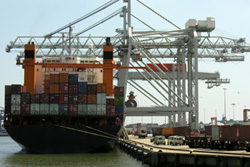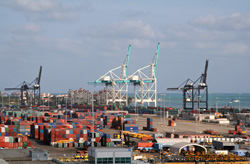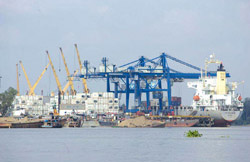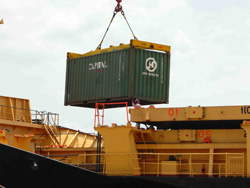Crisis, Consolidation and Contraction
 |
|
In adversity there is opportunity. Container volumes are falling and big shiny new container ships are being delivered in numbers. The need to layup container ships is obvious. The capacity cuts already seen have been significant. But as Fairplay recently pointed out the cuts seen so far have been unevenly spread. PIL and other smaller players on long haul trades seem to be taking out more capacity than the big boys. I have pondered about why they would choose to do that; maybe they |
have a cunning plan? Two thoughts spring to mind. The lines making the deepest cuts have the smaller "big" ships, those that can more easily be deployed to other routes. They may also be more willing and able to test new services as they are less tied to investments in really "big" ships.
Ignoring who is actually operating the ships let's speculate about what all those excess container ships are going to do. Owners are not going to keep them still, if presented with other options. This may mean that the benefits of shipping over hub and spoke operation will undergo a large scale trial. Arguments have cycled back and forth for years and across industries about this. Boeing and Airbus having spent vast sums in research managed to reach different conclusions on the "right" answer. The big players may now have to witness live experiments on an unprecedented scale that could wreck the utilisation rates on the biggest ships doing long haul routes.
Having set the scene I should really give you the answers but instead, I can now take the opportunity to advertise a conference appearance at 7th ASEAN Ports and Shipping 2009, Jakarta 3rd and 4th June 2009. There I will be speaking in more depth about just this subject. It is of course one of particular interest to Indonesia given the potential benefits in sea freight rates it could generate for them. After the conference the paper/slides will be put up on the website for everyone to look at and tell me where I am wrong.
Port Traffic Forecasting Techniques
 |
|
Over the last few years it has often seemed adequate when preparing a market forecast to look at the forecasts for GDP growth, work out how much faster trade will grow, check that it fits with actual growth for the last ten years and then issue that as a considered forecast. Competition assessments sometimes have crept in where there are significant issues but in general the simple and direct forecasting options have been all clients have been willing to pay for or believe. More |
sophisticated forecasting tools exist. In the past we have looked at large scale economic models of countries that can generate forecast from looking at population, economic fundamentals and infrastructure. Such approaches tend to fall foul of inadequate data or model algorithms that cannot be validated. As an alternative the use of scenario planning techniques has provided the "mark to the future" forecast method. This has two advantages;
| |
|
| (1) |
implemented properly it can examine a wide range of future issues that may impact traffic at a port or a terminal and |
| (2) |
it can provide an objective assessment of the probability of a forecast being achieved in practice. |
A key advantage of "mark to the future" is that it does not just rely on looking at the past. It examines what may happen in the future and factors that into the overall forecast. This can have unexpected implications. One example being an unpopular prediction when made; that container traffic would not continue to leap ahead in Hong Kong but that growth would be ceded to terminals in Shenzhen; old news now but when done controversial and prescient.
In the "post credit crisis" world techniques that can examine what may happen in the future may rise in popularity. The potential for "mark to the future" could be recognised as a way of better understanding the risk associated with the traffic forecasts on which our planning relies.
Too Much Tampering?
The Tariff Authority for Major Ports(TAMP) in India have changed its approach to setting tariffs. Though I have to admit I was never one to favour the idea of regulating tariff over the development of free and fair competition. Whilst thinking that TAMP have this time shown remarkable insight to develop their new approach I think they may live to regret developing such a clever set of rules.
 |
|
Starting with the good news, they are providing everyone clarity on what the maximum tariff will be for ports developed under PPP schemes in India’s major ports. The new approach requires the Port Trust to apply to TAMP in advance of seeking bids for a new terminal. They have to ask TAMP to approve a tariff cap. This combined with clear rules for escalating the tariff cap into the future means TAMP have provided the information required to understand the tariff cap over |
the life of any specific PPP scheme. Below that, presumably, anything goes.
Less attractive aspects of the new approach emerge as you try and prepare a submission to TAMP to set a tariff cap. Some of the key issues are:
 |
the method used to calculate the cap tariff, which is very detailed and very specific; |
 |
the method of escalating the tariff (and it being fixed for so long); and |
 |
the cap once assessed will apply to subsequent, similar PPP projects in that port. |
My concerns about the impact on development within the major ports spring mainly from these. Take the example of the method used to calculate the tariff cap it rightly includes and assessment of the capital expenditure and then uses an "acceptable" but fixed rate of return to derive a revenue cap. This is going to be interesting in a world where the "acceptable" rate of return for investors varies. When investment funds are in short supply it may mean Indian ports struggle to compete for funds in the market. Given that the cap applies to all similar PPP projects in a port, there will be a problem if a low capital expenditure project is the first to request a tariff cap. The cap set by such a project will be a low cap. Because other similar projects in the port for at least five years have the same cap no matter what the capital expenditure, the tariff procedure is going to stop quite a few developments. This is going to be a story to watch burn slowly over time!
News Item: Agreement with Hambleton Risk Management
My involvement in claims and disputes has provided me within some of the best learning experiences I have had. It is therefore really pleasing that we have managed to reach an agreement with Hambleton Risk Management, one of the top groups of practitioners in this field to enhance our mutual capability. Hambleton will provide DWA a base in Europe and DWA will represent Hambleton in Singapore and South East Asia.
Hambleton and DWA believe prevention is better than cure. We have in place a range of inspection and advisory services to identify physical, regulatory and commercial risks and thereby assess the potential impact of those risks. DWA and Hambleton also develop prevention and mitigation measures for the risks they identify, always seeking to minimize our clients’ exposure.
Signing off on a positive note...
 |
|
A recent visit to Bangladesh provided me a chance for a quick look at one of this year’s success stories. A combination of a new Government, an economy heavily reliant on agriculture on a good run of harvests, exports that sit at the low end of the cost spectrum for western consumers and a cost advantage over China of 20% means that trade in Bangladesh is still growing; 14.5% between July 08 and March 09 an annualised rate close to 20%. That makes it the top performer. The ports are also less of an issue than they were; shippers and lines providing positive comments about the improvements. |
More capacity and more efficiency is now required. Just what DWA is intending to provide!
|